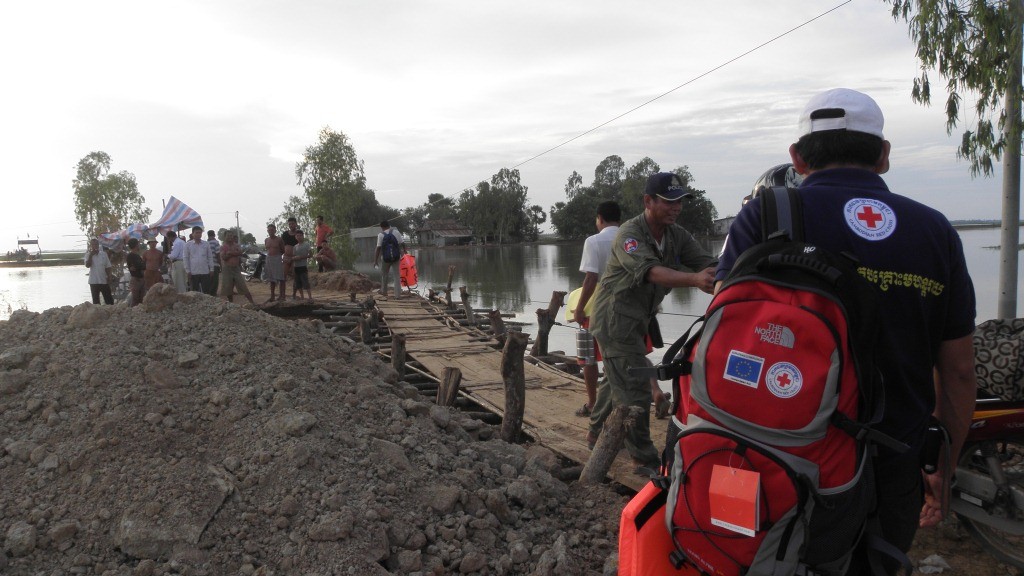
ទឹកជំនន់នៅកម្ពុជា ឆ្នាំ២០១១។ រូបភាព ថតដោយ គណៈកម្មការអឺរ៉ុប, ១១ តុលា ២០១១។ ក្រោមអាជ្ញាប័ណ្ណ CC BY 2.0។
នៅប្រទេសកម្ពុជា ព្យុះ ទឹកជំនន់ និងរន្ទះបាញ់ គឺជាគ្រោះមហន្តរាយធម្មជាតិចម្បង ដែលធ្វើឱ្យបាត់បង់ជីវិតមនុស្សសត្វ និងការបំផ្លិចបំផ្លាញទ្រព្យសម្បត្តិ ខណៈដែល គ្រោះរាំងស្ងួត បង្កឱ្យមានទុក្ខវេទនាយ៉ាងខ្លាំង ជាពិសេសសម្រាប់កសិករ។ នៅក្នុងរបាយការណ៍មួយកាលពីចុងឆ្នាំ២០១៥ អង្គការសហប្រជាជាតិ បានរកឃើញថា កម្ពុជាស្ថិតក្នុងចំណាត់ថ្នាក់ខ្ពស់ទី៧ នៅក្នុងពិភពលោក ជាប្រទេសដែលមានការបាត់បង់ជីវិតមនុស្សទាក់ទងនឹងគ្រោះមហន្តរាយអាកាសធាតុ។ ក្នុងចំណោមមនុស្ស ១០០,០០០ នាក់ មានមនុស្សជាមធ្យម ៨,៤០០ នាក់ ទទួលរងផលប៉ះពាល់ដោយគ្រោះមហន្តរាយ ជារៀងរាល់ឆ្នាំ។1
ទឹកជំនន់ គឺជាគ្រោះមហន្តរាយដែលកើតឡើងញឹកញាប់បំផុត នៅក្នុងប្រទេសកម្ពុជា ហើយបណ្ដាលឱ្យមានចំនួនជាង ៩៧ ភាគរយនៃការស្លាប់បាត់បង់ជីវិត និងជាង ៩១ ភាគរយនៃការបាត់បង់សេដ្ឋកិច្ច។2
នៅក្នុងសន្ទស្សន៍ហានិភ័យ INFORM ឆ្នាំ២០១៨ (ដែលគិតពីការប៉ះពាល់រូបវន្ត និងភាពងាយរងគ្រោះរូបវន្ត ភាពទន់ខ្សោយនៃប្រព័ន្ធសេដ្ឋកិច្ចសង្គម និងកង្វះភាពភាពធន់ក្នុងការទប់ទល់ និងការស្ដារឡើងវិញ) ប្រទេសកម្ពុជា មានអត្រាហានិភ័យខ្ពស់ជាងប្រទេសថៃ ឡាវ ឬវៀតណាម។3
ការប្រែប្រួលអាកាសធាតុ ត្រូវបានរំពឹងទុកថា នឹងបង្កផលប៉ះពាល់យ៉ាងធ្ងន់ធ្ងរ។4;5
ការគ្រប់គ្រងគ្រោះមហន្តរាយ
គណៈកម្មាធិការជាតិគ្រប់គ្រងគ្រោះមហន្តរាយ គឺជាស្ថាប័នដ៏សំខាន់ ដែលទទួលបន្ទុកគ្រប់គ្រងគ្រោះមហន្តរាយ នៅកម្ពុជា។ នៅកម្រិតថ្នាក់ជាតិ គណៈកម្មាធិការនេះ មានសមាជិកចំនួន ២២ រូប មកពីក្រសួងនានា កងកម្លាំងប្រដាប់អាវុធកម្ពុជា អាជ្ញាធរអាកាសចរស៊ីវិល និង កាកបាទក្រហមកម្ពុជា។6 គណៈកម្មាធិការនេះ ជួយទ្រទ្រង់គណៈកម្មាធិការថ្នាក់ខេត្ត ស្រុក និងឃុំ។ ក្រុមគ្រប់គ្រងគ្រោះមហន្តរាយថ្នាក់ភូមិ គឺជាស្ថាប័នថ្នាក់ទាបជាងគេ។
គម្រោងរយៈពេល ៤ឆ្នាំ (២០១៥-២០១៩) កំពុងត្រូវបានអនុវត្តដោយក្រសួងធនធានទឹក និងឧតុនិយម (MOWRAM) ដោយមានជំនួយហិរញ្ញវត្ថុពីកម្មវិធីអភិវឌ្ឍន៍សហប្រជាជាតិ (យូអិនឌីភី)។7 គម្រោងនេះក៏មានការចូលរួមពីក្រសួងកសិកម្ម រុក្ខាប្រមាញ់ និងនេសាទ (MAFF) និងគ.ជ.គ.ម. ហើយកំពុងកាត់បន្ថយគំលាតក្នុងសមត្ថភាពស្ថាប័នសម្របសម្រួលអន្តរក្រសួង និងហេដ្ឋារចនាសម្ព័ន្ធ។ ធាតុសំខាន់នៃគម្រោងនេះ គឺស្ថានីយតាមដានអាកាសធាតុដោយស្វ័យប្រវត្តិ កំពុងត្រូវបានតំឡើងដើម្បីផ្តល់សារប្រកាសឱ្យដឹងមុន។
ប្រទេសកម្ពុជា ក៏កំពុងចូលរួមក្នុងគម្រោង «ការផ្តល់សិទ្ធិអំណាចដល់ស្ត្រី ដើម្បីធានាដល់សង្គមដែលធន់ទ្រាំនឹងអាកាសធាតុ» ជាគម្រោងដែលអង្គការ UN Women កំពុងធ្វើការសម្របសម្រួលជាមួយអង្គការ UN Environment នៅបណ្ដាប្រទេសក្នុងតំបន់អាស៊ីប៉ាស៊ីហ្វិក។8 គម្រោងនេះនឹងដំណើរការចាប់ពីឆ្នាំ ២០១៨-២០២២ ដោយផ្តោតយ៉ាងសំខាន់លើការកាត់បន្ថយហានិភ័យគ្រោះមហន្តរាយ។
ប្រទេសកម្ពុជា បានបង្កើតផែនការសកម្មភាពជាយុទ្ធសាស្ត្រថ្នាក់ជាតិ ដើម្បីកាត់បន្ថយហានិភ័យគ្រោះមហន្តរាយ។
ក្រសួងនីមួយៗ ក៏ពង្រឹងយុទ្ធសាស្ត្រផ្ទាល់ខ្លួន ដូចជា ផែនការសកម្មភាពដើម្បីកាត់បន្ថយហានិភ័យគ្រោះមហន្តរាយក្នុងវិស័យកសិកម្ម ឆ្នាំ២០១៤-២០១៨ របស់ក្រសួង កសិកម្ម និងរុក្ខាប្រមាញ់ ជាដើម។9
ផលប៉ះពាល់
ទិន្នន័យដែលចេញដោយគណៈកម្មាធិការជាតិគ្រប់គ្រងគ្រោះមហន្តរាយបានបង្ហាញថា គ្រោះមហន្តរាយធម្មជាតិនៅក្នុងឆ្នាំ២០១៧ បានបណ្ដាលឱ្យមាន ១០៣នាក់បាត់បង់ជីវិត ១២០នាក់រងរបួស និងប៉ះពាល់ជាង ២០០០ គ្រួសារ។10 តួលេខនេះ គឺជាការធ្លាក់ចុះ បើធៀបទៅឆ្នាំ២០១៦ ដែលកាលនោះមានមនុស្សចំនួន ១៣០ នាក់ត្រូវបានបាត់បង់ជីវិត។11
ខ្យល់ព្យុះ និងទឹកជំនន់
ជាធម្មតា ព្យុះទីហ្វុង មិនវាយប្រហារមកលើប្រទេសកម្ពុជាពេញលេញទេ។ ប៉ុន្តែកម្ពុជាទទួលរងឥទ្ធិពលព្យុះទីហ្វុង ដែលបានវាយប្រហារប្រទេសចិន និងវៀតណាម ដែលអាចបង្កឲ្យខូចខាតផ្ទះសម្បែង និងមានទឹកជំនន់ធ្ងន់ធ្ងរដោយសារទឹកទន្លេឡើង។ ការបាក់ច្រាំងទន្លេ ក៏ជាមូលហេតុមួយ ដែលបណ្ដាលឱ្យខូចខាតដល់ផ្ទះសម្បែង។
នៅឆ្នាំ២០១៧ ខ្យល់ព្យុះបានបង្កឱ្យមនុស្សចំនួន ៦នាក់បានបាត់បង់ជីវិត ៥៥នាក់រងរបួស ផ្ទះ ៥៧៩ខ្នងត្រូវបានបំផ្លាញ និង៤០២៧ខ្នងទៀតរងការខូចខាត។12 នេះគឺជាតួលេខទាបជាងឆ្នាំ២០១៦ ដែលពេលនោះ ខ្យល់ព្យុះបានបណ្តាលឱ្យមនុស្ស ២១ នាក់ស្លាប់ និង១៩៣ នាក់រងរបួស និងបំផ្លាញផ្ទះអស់ ១៩៩៧ ខ្នង។13
ទឹកជំនន់ដ៏ធ្ងន់ធ្ងរបំផុតនៅឆ្នាំ២០១៣ បានធ្វើឲ្យបាត់បង់ជីវិតមនុស្ស ១៦៨នាក់ និងបានបង្ខំឲ្យគ្រួសារចំនួន ៣១,០០០គ្រួសារ បោះបង់ចោលផ្ទះសម្បែងរបស់ខ្លួន14 ព្រមទាំងបានធ្វើឲ្យខាតបង់ថវិកា អស់ចំនួន ៣៥៦ លានដុល្លារសហរដ្ឋអាមេរិក យោងតាមគណៈកម្មាធិការជាតិគ្រប់គ្រងគ្រោះមហន្តរាយ។15 ធនាគារអភិវឌ្ឍន៍អាស៊ី បានផ្តល់ទឹកប្រាក់ចំនួន ៨១,៧ លានដុល្លារសហរដ្ឋអាមេរិក សម្រាប់ការសាងសង់ផ្លូវឡើងវិញប្រវែងជិត ៤០០ គីឡូម៉ែត្រ ស្ពានចំនួន៣ និងប្រព័ន្ធធារាសាស្ត្រចំនួន៩ ក្នុងខេត្តចំនួន៦។16
ចាប់តាំងពីឆ្នាំ២០០០ មក ទឹកជំនន់នៅឆ្នាំ២០១១ គឺជាទឹកជំនន់ធ្ងន់ធ្ងរជាងគេបំផុត នៅរយៈពេលមួយទសវត្សរ៍ចុងក្រោយនេះ ហើយបានបណ្តាលឱ្យមានការខូចខាត និងការស្លាប់ច្រើនជាង គ្រោះមហន្តរាយធម្មជាតិផ្សេងទៀត នៅពេលដែលទន្លេសាប និងទន្លេមេគង្គបានជន់លិចដោយសារតែមានភ្លៀងធ្លាក់ ខ្ពស់ជាងកម្រិតទឹកភ្លៀងធម្មតា។ ចំនួនអ្នកស្លាប់មាន ២៤៧ នាក់17 ហើយប្រមាណ ៥០,០០០ គ្រួសារ បានផ្លាស់ទីលំនៅ និងផ្ទៃដីដាំដុះប្រមាណ ២៧០,០០០ ហិកតា រងការបំផ្លិចបំផ្លាញ។18 វាគឺជាគ្រោះមហន្តរាយ ដែលមានទំហំធំ និងការខាតបង់ខ្ពស់បំផុតនៅក្នុងប្រវត្តិសាស្ត្រ។
រន្ទះបាញ់
ខណៈដែល ប្រទេសភាគច្រើនដែលស្ថិតនៅជិតនឹងខ្សែអេក្វាទ័រ មានអត្រាខ្ពស់ក្នុងការវាយប្រហារដោយរន្ទះ19 ប្រជាជននៅតាមជនបទភាគច្រើននៅប្រទេសកម្ពុជា មានកម្រិតការស្លាប់ និងការរងរបួសខ្ពស់ ដោយសាររន្ទះបាញ់ ដោយហេតុថា ប្រជាជនមួយចំនួនធំ ភាគច្រើនធ្វើការងារនៅកណ្តាលវាល។ ក្នុងឆ្នាំ២០១៦ រន្ទះបានសម្លាប់មនុស្ស ១០៨នាក់ របួស ១០៥នាក់ បានធ្វើឱ្យខូចខាតផ្ទះសម្បែង ៩ខ្នង និងសម្លាប់សត្វ ៨០ក្បាល។20 តួលេខនៃការបាត់បង់ជីវិត គឺទាបជាងឆ្នាំ ២០១៧ ដែលរន្ទះបានសម្លាប់មនុស្ស ៨០នាក់ និងបានធ្វើឱ្យរបួស ៦៣នាក់។21
គ្រោះរាំងស្ងួត
ទឹកជំនន់ អាចកើតមានឡើងប៉ុន្មានខែ បន្ទាប់ពីមានគ្រោះរាំងស្ងួត (ភ្លៀងធ្លាក់ពន្យាដល់ ដើម ឬចុងរដូវ)។ ឧទាហរណ៍ នៅឆ្នាំ២០១២ មានគ្រោះរាំងស្ងួតដែលបានធ្វើឲ្យប៉ះពាល់ ដល់មនុស្សរាប់លាននាក់ ហើយក្រោយមកក៏មានទឹកជំនន់កើតឡើងបន្ត ដែលបណ្តាលឱ្យមានផលប៉ះពាល់យ៉ាងច្រើន។ ទោះបីជាយ៉ាងណាក៏ដោយ រយៈពេលរាំងស្ងួត ២០ថ្ងៃ ក្នុងកំឡុងរដូវវស្សា (ខែឧសភា ដល់ ខែវិច្ឆិកា) ក៏អាចបង្កឲ្យមានការខាតបង់យ៉ាងធ្ងន់ធ្ងរដល់ផលដំណាំដែរ។ គ្រោះរាំងស្ងួត គឺជាគ្រោះហានិភ័យដ៏ធ្ងន់ធ្ងរមួយដោយឡែក ដោយសារតែកង្វះនូវប្រព័ន្ធស្រោចស្រព ដែលប្រព័ន្ធធារាសាស្ត្រមានត្រឹមប្រហែល ២០ ភាគរយ ប៉ុណ្ណោះ។22 កន្លងមក ភ្លើងឆេះព្រៃ មិនមែនជាការព្រួយបារម្ភយ៉ាងសំខាន់ នៅក្នុងប្រទេសកម្ពុជាទេ ប៉ុន្តែការប្រមើលមើលនៃការរាំងស្ងួតដែលមានរយៈពេលវែង និងធ្ងន់ធ្ងរ ហើយផ្សាភ្ជាប់នឹងការប្រែប្រួលអាកាសធាតុទៀតនោះ វាអាចនឹងបង្កើនហានិភ័យសម្រាប់ប្រទេសកម្ពុជា លើបញ្ហាភ្លើងឆេះព្រៃ។23
ជំងឺរាតត្បាត
ការប្រែប្រួលអាកាសធាតុ អាចធ្វើឱ្យកម្ពុជាងាយរងនូវការផ្ទុះឡើងនៃជំងឺ និងការរាតត្បាតដែលបង្កឡើងដោយទឹក ដូចជា ជំងឺគ្រុនចាញ់ និងជំងឺគ្រុនឈាម។24 ក្នុងរយៈពេលកន្លងមកនេះ ប្រទេសកម្ពុជា បានដោះស្រាយបញ្ហាជំងឺឆ្លងជាសកលបានយ៉ាងល្អ ក្នុងនោះរួមមាន ការផ្ទុះឡើងនៃជំងឺផ្តាសាយបក្សី H5N1 តាមរយៈការហាមឃាត់ការនាំចូលពីប្រទេសជិតខាង។25 ប្រសិទ្ធភាព អាចអាស្រ័យលើកម្រិតខ្ពស់នៃកម្មវិធីអភិវឌ្ឍន៍ និងការផ្តល់មូលនិធិសុខភាព និងវត្តមានដ៏រឹងមាំរបស់ទីភ្នាក់ងារអភិវឌ្ឍន៍ ដូចជាអង្គការសុខភាពពិភពលោកជាដើម។26
បានធ្វើបច្ចុប្បន្នភាព៖ ១៦ ឧសភា ២០១៩
ឯកសារយោង
- 1. ការិយាល័យអង្គការសហប្រជាជាតិ សម្រាប់ការកាត់បន្ថយហានិភ័យនៃគ្រោះមហន្តរាយ។ ២០១៥។ តម្លៃមនុស្សទាក់ទងនឹងគ្រោះមហន្តរាយដែលពាក់ព័ន្ធនឹងអាកាសធាតុ ១៩៩៥-២០១៥។ UNISDR និងមជ្ឈមណ្ឌលសម្រាប់ការស្រាវជ្រាវស្តីពីរោគរាតត្បាតបង្កឡើងដោយគ្រោះមហន្តរាយ។ http://www.unisdr.org/2015/docs/climatechange/COP21_WeatherDisastersReport_2015_FINAL.pdf ចូលអាន ២៨ វិច្ឆិកា ២០១៥។
- 2. គេហទំព័រ Prevention Web, ប្រវត្តិគ្រោះមហន្តរាយ និងហានិភ័យនៃប្រទេសកម្ពុជា។ https://www.preventionweb.net/countries/khm/data ចូលអាន ២៦ មករា ២០១៩។
- 3. ដូចឯកសារយោងខាងដើម។
- 4. រាជរដ្ឋាភិបាលកម្ពុជា។ “ផែនការយុទ្ធសាស្ត្រនៃការប្រែប្រួលអាកាសធាតុនៅកម្ពុជា ២០១៤-២០១៣។” ចូលអាន ៣០ តុលា ២០១៥។ http://www.kh.undp.org/content/dam/cambodia/docs/EnvEnergy/CCCAProjects/Cambodia%20climate%20change%20strategic%20plan%202014-2023.pdf
- 5. មុំ ចាន់តារាសូឡី។ “ការគ្រោងធ្វើផែនការ ដើម្បីលើកកម្ពស់ភាពធន់នឹងអាកាសធាតុ នៅក្នុងការអភិវឌ្ឍរបស់កម្ពុជា។” ទីភ្នាក់ងារសារព័ត៌មានកម្ពុជា, ចេញផ្សាយថ្ងៃទី៩ កក្កដា ២០១៥។ ចូលអាន ៣០ តុលា ២០១៥។ http://www.akp.gov.kh/?p=65560
- 6. គណៈកម្មាធិការជាតិគ្រប់គ្រងគ្រោះមហន្តរាយ។ ចូលអាន ២៥ តុលា ២០១៥។ ជាភាសាខ្មែរ http://www.ncdm.gov.kh
- 7. យូអិនឌីភី កម្ពុជា ឆ្នាំ២០១៩។ ពង្រឹងព័ត៌មានអាកាសធាតុ និងប្រព័ន្ធប្រកាសអាសន្នជាមុន នៅកម្ពុជា។ http://www.kh.undp.org/content/cambodia/en/home/operations/projects/build-resilience/early-warning-systems.html ចូលអាន ២៦ មករា ២០១៩។
- 8. អង្គការ UN Women ២០១៨។ ចាប់ផ្ដើមគម្រោងដើម្បីផ្តល់សិទ្ធិអំណាចដល់ស្ត្រី ក្នុងការសម្រេចចិត្តដែលពាក់ព័ន្ធនឹងការប្រែប្រួលអាកាសធាតុ នៅកម្ពុជា។ http://asiapacific.unwomen.org/en/news-and-events/stories/2018/12/project-to-empower-women-in-climate-change-decisions ចូលអាន ២៦ មករា ២០១៩។
- 9. អគ្គនាយកដ្ឋានកសិកម្ម។ ផែនការសកម្មភាពដើម្បីកាត់បន្ថយហានិភ័យគ្រោះមហន្តរាយក្នុងវិស័យកសិកម្ម ឆ្នាំ២០១៤-២០១៨។ ភ្នំពេញ៖ ក្រសួងកសិកម្ម រុក្ខាប្រមាញ់ និងនេសាទ, ខែធ្នូ ឆ្នាំ២០១៣។ ចូលអាន ២៦ មករា ២០១៥។ https://coin.fao.org/coin-static/cms/media/21/14109270844140/etfinal_national_poa_drr_gda_main_eng.pdf
- 10. ប៉ិច សុធារី ឆ្នាំ២០១៧។ “តួលេខនៃការស្លាប់ដោយសារគ្រោះធម្មជាតិនៅប្រទេសកម្ពុជា មានការធ្លាក់ចុះ” កាសែតខ្មែរថាមស៍, ចេញផ្សាយថ្ងៃទី២៦ ធ្នូ ២០១៧។ http://www.khmertimeskh.com/5098124/kingdom-sees-drop-natural-disaster-deaths ចូលអាន ២៩ ធ្នូ ២០១៧។
- 11. មុំ គន្ធា ឆ្នាំ២០១៦, “ទិដ្ឋភាពទូទៅនៃគ្រោះមហន្តរាយធម្មជាតិ ឆ្នាំ២០១៦” កាសែតខ្មែរថាមស៍, ចេញផ្សាយថ្ងៃទី២៣ ធ្នូ ២០១៦។ http://www.khmertimeskh.com/news/33516/overview-of-2016-natural-disasters ចូលអាន ២៣ កក្កដា ២០១៧។
- 12. ប៉ិច សុធារី ឆ្នាំ២០១៧។
- 13. មុំ គន្ធា ឆ្នាំ២០១៦។
- 14. ឡេង, ហេងអាន។ របាយការណ៍របស់ប្រទេសកម្ពុជា ស្តីពីការគ្រប់គ្រងគ្រោះមហន្តរាយ។ ទីក្រុងកូបេ៖ មជ្ឈមណ្ឌលកាត់បន្ថយគ្រោះមហន្តរាយ (ADRC), កុម្ភៈ ២០១៤។ ដកស្រង់ ៣០ មករា ២០១៥។ http://www.adrc.asia/countryreport/KHM/2013/KHM_CR2013B.pdf
- 15. ប៉ិច សុធារី។ “រដ្ឋាភិបាលនិយាយថា ខ្លួនត្រៀមខ្លួនរួចរាល់ទប់ទល់នឹងទឹកជំនន់ហើយ។” កាសែតភ្នំពេញប៉ុស្តិ៍, ចេញផ្សាយថ្ងៃទី១០ កក្កដា ២០១៤។ ចូលអាន ៣០ មករា ២០១៥។ https://www.phnompenhpost.com/national/gov%E2%80%99t-says-it%E2%80%99s-ready-floods
- 16. កាសែត Xinhua។ “ធនាគារអភិវឌ្ឍន៍អាស៊ី ផ្តល់ទឹកប្រាក់ ៨១,៧ លានដុល្លារអាមេរិកដល់កម្ពុជា សម្រាប់ការស្តារឡើងវិញក្រោយទឹកជំនន់។” កាសែត Global Times, ចេញផ្សាយថ្ងៃទី២៣ មេសា ២០១៤។ ចូលអាន ៣០ មករា ២០១៥។ http://www.globaltimes.cn/content/856315.shtml
- 17. គេហទំព័រ Relief Web។ “ប្រទេសកម្ពុជា៖ ទឹកជំនន់ – កញ្ញា ២០១១។” ចូលអាន ៣០ តុលា ២០១៥។ http://reliefweb.int/disaster/fl-2011-000148-khm
- 18. អង្គការកម្មវិធីស្បៀងអាហារពិភពលោក។ “របាយការណ៍អង្កេត អំពីការស្តារឡើងវិញ ក្រោយគ្រោះទឹកជំនន់ នៅប្រទេសកម្ពុជា៖ ឧសភា ២០១២។” ដកស្រង់ ៣០ តុលា ២០១៥។ https://opendevelopmentcambodia.net/dataset/?id=cambodia-post-flood-relief-and-recovery-survey
- 19. អង្គការណាសាឃ្លាំមើលភពផែនដី។ “អត្រានៃផ្លេកបន្ទោរ។” ដកស្រង់ ២៥ តុលា ២០១៥។ http://earthobservatory.nasa.gov/IOTD/view.php?id=85600&eocn=home&eoci=iotd_previous
- 20. មុំ គន្ធា ឆ្នាំ២០១៦។
- 21. ប៉ិច សុធារី ឆ្នាំ២០១៧។
- 22. ឡេង, ហេងអាន។ របាយការណ៍របស់ប្រទេសកម្ពុជា ស្តីពីការគ្រប់គ្រងគ្រោះមហន្តរាយ។ ទីក្រុងកូបេ៖ មជ្ឈមណ្ឌលកាត់បន្ថយគ្រោះមហន្តរាយ (ADRC), កុម្ភៈ ២០១៤។ ដកស្រង់ ៣០ មករា ២០១៥។ http://www.adrc.asia/countryreport/KHM/2013/KHM_CR2013B.pdf
- 23. មុំ ចាន់តារាសូឡី។ “ការគ្រោងធ្វើផែនការ ដើម្បីលើកកម្ពស់ភាពធន់នឹងអាកាសធាតុ នៅក្នុងការអភិវឌ្ឍរបស់កម្ពុជា។” ទីភ្នាក់ងារសារព័ត៌មានកម្ពុជា, ចេញផ្សាយថ្ងៃទី៩ កក្កដា ២០១៥។ ចូលអាន ៣០ តុលា ២០១៥។ http://www.akp.gov.kh/?p=65560
- 24. Emily Wight។ “គ្រោះរាំងស្ងួត ទឹកជំនន់ ជំងឺ៖ ស្ថានភាពពិតនៃកម្ពុជា ដែលត្រូវបានវាយប្រហារ ដោយការប្រែប្រួលអាកាសធាតុ។” កាសែតភ្នំពេញប៉ុស្តិ៍, ចេញផ្សាយថ្ងៃទី១១ មេសា ២០១៤។ ដកស្រង់ ៣០ តុលា ២០១៥។ http://www.phnompenhpost.com/7days/droughts-flooding-disease-reality-cambodia-has-been-hit-climate-change
- 25. Thomas Miller។ “អ្នកជំនាញនិយាយថា នៅកម្ពុជា ជំងឺផ្តាសាយបក្សីនៅតែជាកត្តាគំរាមកំហែងមួយ។” កាសែតភ្នំពេញប៉ុស្តិ៍, ចេញផ្សាយថ្ងៃទី១៧ កញ្ញា ២០១០។ ដកស្រង់ ៣០ តុលា ២០១៥។ https://www.phnompenhpost.com/national/experts-say-bird-flu-cambodia-still-threat
- 26. អង្គការសុខភាពពិភពលោក។ “ប្រទេសកម្ពុជា៖ យុទ្ធសាស្ត្រនៃកិច្ចសហប្រតិបត្តិការ។” ដកស្រង់ ៣០ តុលា ២០១៥។ http://www.who.int/countryfocus/cooperation_strategy/ccsbrief_khm_en.pdf?ua=1

